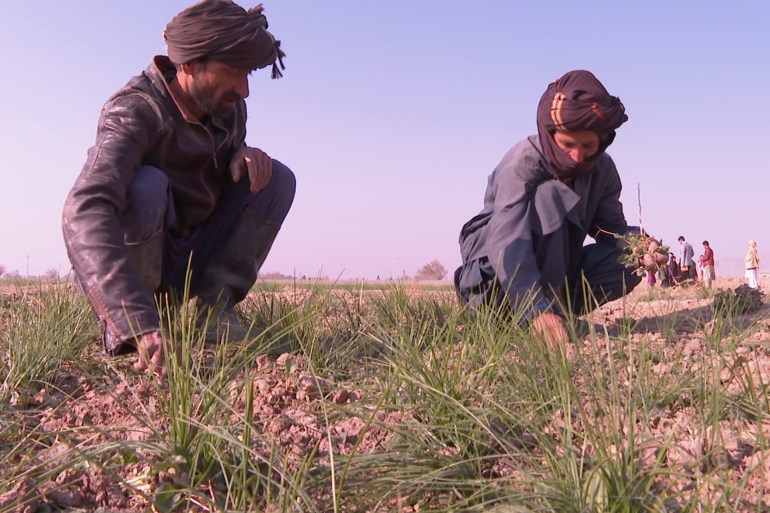Afghanistan has become one of the largest producers of saffron and the best seller in the world in the past two decades, as its favorable geographical location - with its mountainous climate and rich soil - made it suitable for saffron cultivation, but drought and recent political changes in the country have affected the cultivation and trade of saffron in Afghanistan.
Afghans have been cultivating saffron since 2006 after former Iranian President Mahmoud Ahmadinejad presented his Afghan counterpart Hamid Karzai with saffron bulbs, and the latter presented it to the people of Herat province in western Afghanistan due to its proximity to Iran.
Saffron dealer Azizullah Rahma told Al Jazeera Net, "The quality of Afghan saffron and its Iranian color and others has exceeded due to the appropriate climate and soil that saffron is tried for the first time. According to agricultural experts, sandy soil is a suitable environment for saffron, and this is the main reason behind the global fame of Afghan saffron."
The cultivation of saffron in Herat and other states of Afghanistan gradually spread as an alternative to poppy cultivation and drugs, and led to the decline of its cultivation in Herat Province and other regions in western Afghanistan.
Despite the spread of the Corona pandemic, which seriously affected the global economy, Afghanistan was able to produce saffron and export it abroad, and Afghanistan - with its market share of 12.8% of global exports - occupies third place after Iran and India in the production of saffron, which has the ability to lift millions out of poverty. It brings millions of dollars in income to farmers, which greatly boosts the Afghan economy.
Traders and farmers suffer from a lack of rain and drought this year (Al-Jazeera)
Afghan saffron production
The head of the Afghan Saffron Exporters Association, Muhammad Ashraf Qasimi, told Al Jazeera Net, "The production of saffron in Afghanistan has doubled in the past few years, and in 2018, the value of its total global exports amounted to $21.25 million, and in 2019 it amounted to $28.94 million, and India's share of exports was about 15 One million dollars for being one of the most expensive spices in the world.
Afghani saffron is exported to 27 countries, the most important of which are Qatar, China, India and the United Arab Emirates.
Azizullah Rahmati told Al Jazeera Net, "After the collapse of the previous Afghan government and the Taliban's accession to power in Afghanistan, the process of exporting abroad stopped. Now we send saffron to Pakistan and from there to other countries. This process needs time and additional taxes. I ask the new authorities to find an immediate solution to this." the problem".
The price of saffron has doubled this year 4 times and it cannot be exported abroad due to US warnings and the closure of airports. Farmers say that saffron cannot be saved like other commodities because it loses its color and taste.
"Saffron is rare and the needs are high, so its price has increased, but we are no longer able to export saffron to most countries. Last year, we concluded agreements with the United Arab Emirates and China, but there is now no room for export," businessman Mohammed Rafie told Al Jazeera Net.
Herat Province annually produces 95% of saffron in Afghanistan (Al-Jazeera)
many obstacles
Traders and farmers suffer from the lack of rain and drought this year, and this threatens the lives of families who live on saffron production all year round.
The official statistics of agriculture in Herat show that more than 20,000 families are engaged in harvesting, processing and packing saffron.
Even some saffron growers were disappointed with their continued activity in the saffron cultivation sector, as the lack of rainfall and drought reduced the yield by 60% to 70%.
Abdul Ahad Karim, one of the saffron farmers in Herat state, told Al Jazeera Net, "I harvested 450 kilograms of saffron last year, but this year not all crops reached 100 kilograms of saffron. The level of the saffron crop this year was very low and we lost, what do I benefit from the high prices? I don't own saffron and many like me are expressing their disappointment in investing in this sector."
The state of Herat annually produces 95% of saffron, and in the past years it has exported approximately 18 to 20 tons of pure saffron to global and local markets, but officials in the Herat Department of Agriculture say that the maximum harvest of pure saffron may not exceed 10 tons this year.
Local authorities in Herat province in western Afghanistan acknowledge the problems of saffron traders and farmers.
Mullah Bacha Islamiyar told Al Jazeera Net, "We are trying to provide the necessary facilities for the export of saffron, and a Chinese businessman has expressed his willingness to invest in this sector."

